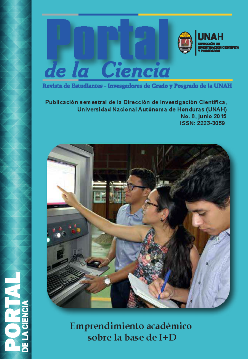Bacteriological characterization irrigation ponds and the relationship with the larval infestation rate of Anopheles albimanus
DOI:
https://doi.org/10.5377/pc.v8i0.2159Keywords:
malaria, bacterium, Anopheles, coliform, gapsAbstract
The purpose of this study was to establish the relationship of the bacteriologic contamination by organic matter of the irrigation pond and the infestation larval index of Anopheles albimanus; a tool for monitoring the vector control in aquatic phase.
The type of study is transverse descriptive with statistic calculating of correlation coefficient of Pearson. It taked water samples of the pont, to for establish two elements, one of them, was to determine the contamination for total coliform, fecal coliform and Escherichia coli. In the other, we determined the infestation larval index of Anopheles albimanus, according to International Standards (PAHO/WHO).
8 irrigation pounds, were monitored in this study. In all of them, we detected a high bacteriologic contamination by total coliform, fecal coliform and Escherichia coli. The correlation coefficient of Pearson between the study´s variable was near to cero, suitable, there was no relationship of the bacteriologic contamination and the infestation larval index of Anopheles albimanus.
There are many factors (sunlight, temperature, salt concentration, etc.) in the biotope of the mosquitoes that have an intervention in the biologic cycle of them.
Revista Portal de Ciencias, No. 8, June 2015: 59-73
Downloads
981
Downloads
Published
How to Cite
Issue
Section
License
© Revista Portal de la Ciencia
Los autores/as que publiquen en esta revista aceptan las siguientes condiciones:
De acuerdo con la legislación de derechos de autor, Revista Portal de la Ciencia, reconoce y respeta el derecho moral de los autores, así como la titularidad del derecho patrimonial, el cual será cedido a la revista para su difusión en acceso abierto en versión impresa y en formato digital. Al formar parte de múltiples indexadores, bases de datos y sistemas de referencia, los artículos que sean publicados por Revista Portal de la Ciencia se encontrarán visibles y serán descargados también de estos sitios web, indicando, en todos los casos, la autoría de los artículos, la fecha de publicación y el número de la revista al que corresponden.

Este obra está bajo una licencia de Creative Commons Reconocimiento-NoComercial 4.0 Internacional.
Usted está en libertad de:
- Compartir: copiar y redistribuir el material en cualquier medio o formato
- Adaptar: remezclar, transformar y crear a partir del material
Bajo las siguientes condiciones:
- Reconocimiento: Usted debe darle crédito a esta obra de manera adecuada, proporcionando un enlace a la licencia, e indicando si se han realizado cambios. Puede hacerlo en cualquier forma razonable, pero no de forma tal que sugiera que usted o su uso tienen el apoyo del licenciante.
- Uso no comercial: Usted no puede hacer uso del material con fines comerciales.




